Dell U2311H: E-IPS, Full Adjustments, and DisplayPort
by Chris Heinonen on September 27, 2011 12:20 AM ESTBrightness and Contrast
When pushed to its maximum brightness level with maximum contrast, the Dell U2311H can manage to put out over 300 cd/m2 of light from a pure white screen. This is far brighter than most of us would like (other than perhaps Brian), and it does result in very washed out highlights, mostly related to the contrast level. This isn’t a level you would work at often, but if you needed to because of direct sunlight, the Dell could manage that. When keeping the contrast a maximum but reducing the brightness down to 0, the light output drops down to just over 100 cd/m2 whichis much easier on the eyes.
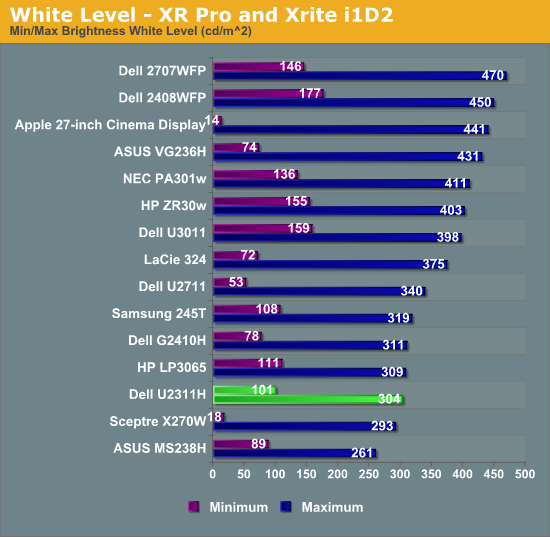
At these same brightness and contrast levels, the light output of an all black screen is 0.303 nits with max brightness, and 0.098 with minimum brightness. I should note that these measurements were taken with an Xrite i1DisplayPro meter instead of the i1Display2, as it does much better reading lower levels of light output. Unfortunately ColorEyesPro does not support this meter at this point and so I couldn’t use it for the whole calibration.
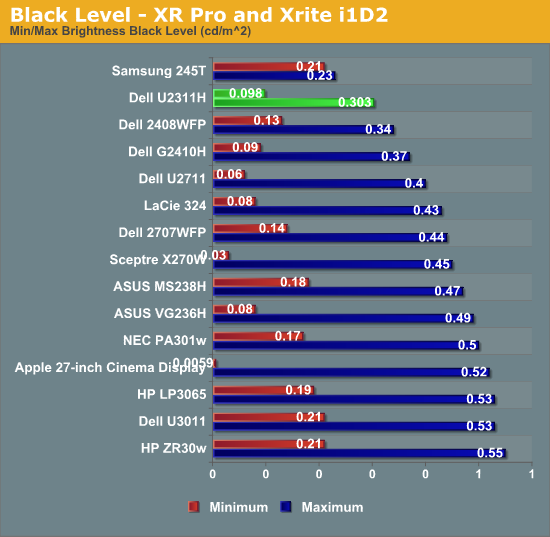
Looking at the On/Off contrast ratio that this creates, we see that both of these produce right around 1,000:1, so you can choose your preferred light output and you will likely get a contrast ratio right around the same level.
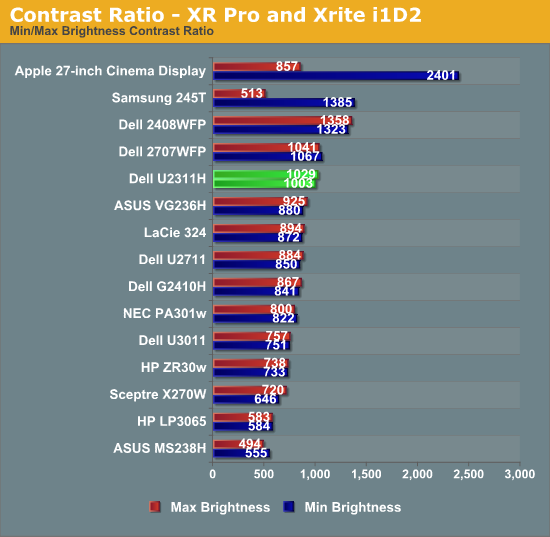
Brightness Uniformity
With 200 nits of light output in the middle of the screen for a white image, the light output drops as low as 161 nits on the left edge of the screen, while staying close to 200 nits on the right side of the display. I’m not sure if it is the layout of the backlights or something else causing this, but the light output is clearly less on the left side of the panel.
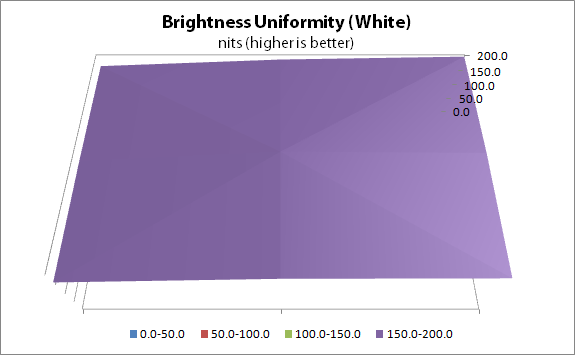
With a black screen, we see the same results. Light output is again higher on the right side of the display and lower at the left, with the upper-right corner being the brightest in both cases.
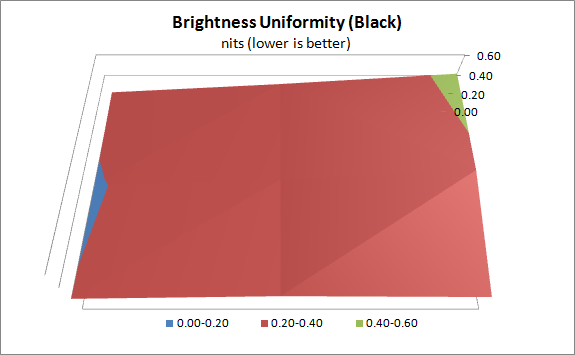










65 Comments
View All Comments
pjfan75 - Tuesday, September 27, 2011 - link
Can you post the calibration settings you used?Thanks!
cheinonen - Tuesday, September 27, 2011 - link
I will grab the settings I used when I hook it up for the input lag test, but since the majority of the work is done with the LUTs in your graphics chip, and not in the display itself, it really won't get you that much of an improvement over the stock settings unfortunately.Zoomer - Tuesday, September 27, 2011 - link
How about a review of HP's line, the ZR24w, etc, or maybe even a comparison?Makaveli - Tuesday, September 27, 2011 - link
I own a ZR24w and I would love to see this. From what I have researched the HP screen uses a real 8 bit panel and would love to see this compared to the 6bit+AFC in this. I'm sure if the Dell 24 inch version is also a non 8 bit panel?TegiriNenashi - Tuesday, September 27, 2011 - link
EOMthe_engineer - Tuesday, September 27, 2011 - link
I Love these monitor reviews. Thanks for working hard on this! I would REALLY love to see a comparison of the current monitor technologies (H-IPS; E-IPS; Samsung's newest tech; TN Panels; Discussion of diffrent styles of LED backlights etc....) and which monitor lines we can find each tech in. This is a very complex issue and actually very pressing for those of us amateur turning-pro photographers and graphic designers on a budget. I've even seen some 40"+ LED backlit Televisions that claim to use IPS technology that i've considered for a display mostly for the price per inch ratio seems so good. Any thoughts on why that might be a bad idea if they are IPS panels?fausto412 - Wednesday, September 28, 2011 - link
yes, i would like to see comparison of technologies...TwinIon - Tuesday, September 27, 2011 - link
I own three of these. Great monitors for the price, but wait for a Dell sale. I got mine for closer to $250 each.Displayport was a real benefit for me since I wanted to use the screens for eyefinity, which requires DP for at least one monitor. The ability to adjust the screens has also proved very important for eyefinity.
xi1inx - Tuesday, September 27, 2011 - link
I remember in the last 12 mouth, another Dell IPS screen was reviewed here. I recall this monitor have also the same price and have a Genesys board inside to drive the lcd. It's perhaps the same monitor with the dvi port instead, So, I saw many reader comments say this ips lcd is bad. I prefer at this point to pursage a nice and bright used Apple Cinema Display HD 23" for the same price. I very happy with this screen and I'm not regrating to don't have buy the Dell one.I think the Apple Cinema Display HD 23" could be a good comparison monitor to compare with new incomers, if you could found one like new. It perhaps an old monitor but it certainly clash with the Dell offers.
Despoiler - Tuesday, September 27, 2011 - link
Check out the NEC EA231WMi. It has since been discontinued for a newer model with a LED backlight, but I got it just south of $300. It suffers none of the issues Dell's E-IPS panels do. It can be calibrated to be quite accurate. In fact you can download a calibration file from TFT Central from their review. You can get .inf files for 75hz and 83hz over display port. There is no input lag or ghosting that I can detect and I play a lot of video games. The stand on it is epicly good. Simply put there are a lot better and cheaper E-IPS panels than what Dell offers. NEC is worth the look.